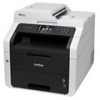Brother International MFC-9340CDW Network Users Manual - English - Page 130
Wireless network terms and concepts (For DCP-9020CDW, MFC-9130CW, MFC-9330CDW and MFC-9340CDW)
 |
View all Brother International MFC-9340CDW manuals
Add to My Manuals
Save this manual to your list of manuals |
Page 130 highlights
11 Wireless network terms and concepts (For DCP-9020CDW, MFC-9130CW, MFC-9330CDW and MFC-9340CDW) 11 Specifying your network 11 SSID (Service Set Identifier) and channels 11 You need to configure the SSID and a channel to specify the wireless network you want to connect to. SSID Each wireless network has its own unique network name and it is technically referred to as an SSID. The SSID is a 32-byte or less value and is assigned to the access point. The wireless network devices you want to associate to the wireless network should match the access point. The access point and wireless network devices regularly send wireless packets (referred to as beacons), which have the SSID information. When your wireless network device receives a beacon, you can identify wireless networks that are close enough to connect to. Channels Wireless networks use channels. Each wireless channel is on a different frequency. There are up to 14 different channels that can be used when using a wireless network. However, in many countries the number of channels available is restricted. Security terms 11 Authentication and encryption 11 11 Most wireless networks use some kind of security settings. These security settings define the authentication (how the device identifies itself to the network) and encryption (how the data is encrypted as it is sent on the network). If you do not correctly specify these options when you are configuring your Brother wireless machine, it will not be able to connect to the wireless network. Therefore care must be taken when configuring these options. Please see Supported protocols and security features on page 137 for which authentication and encryption methods your Brother wireless machine supports. 124















